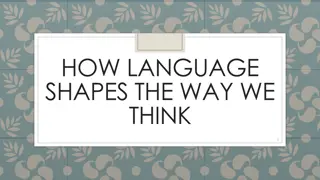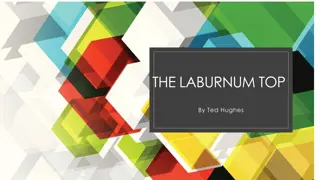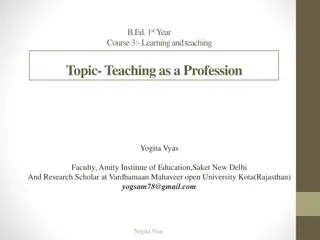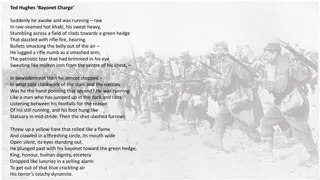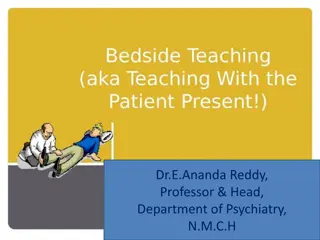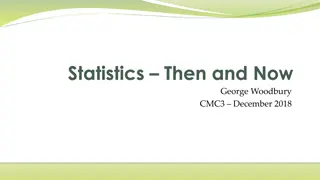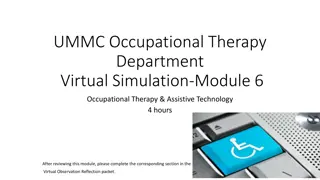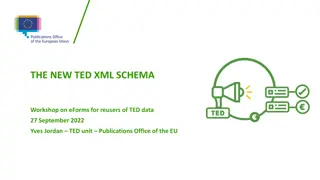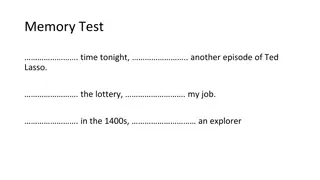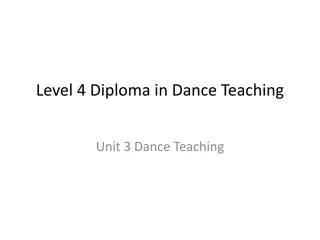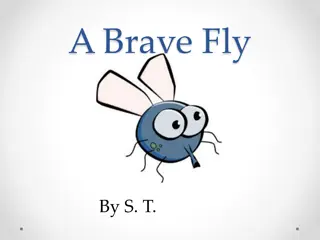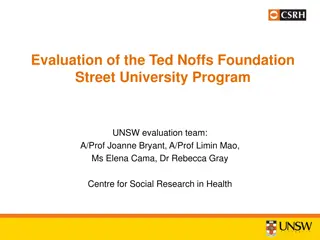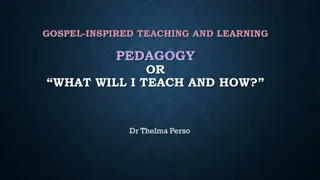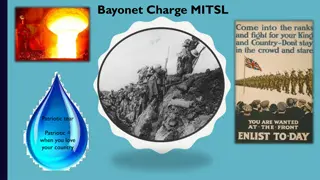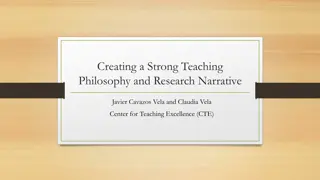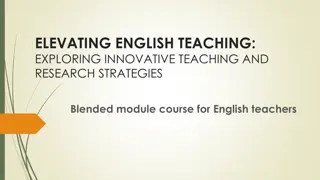Innovative Teaching Strategies Inspired by Ted Lasso
Embark on a journey to revamp your teaching methods with inspiration from Ted Lasso. Engage in interactive sessions, reflect on classroom practices, and foster a supportive learning environment. Explore ideas to enhance student-teacher connections and meet basic needs for a holistic educational approach.
Download Presentation

Please find below an Image/Link to download the presentation.
The content on the website is provided AS IS for your information and personal use only. It may not be sold, licensed, or shared on other websites without obtaining consent from the author.If you encounter any issues during the download, it is possible that the publisher has removed the file from their server.
You are allowed to download the files provided on this website for personal or commercial use, subject to the condition that they are used lawfully. All files are the property of their respective owners.
The content on the website is provided AS IS for your information and personal use only. It may not be sold, licensed, or shared on other websites without obtaining consent from the author.
E N D
Presentation Transcript
How to Teach like Ted Lasso
Open House Pop-In PD Rules 1. It s 90 minutes the CHALLENGE is to be as PRESENT as possible. (oxygen) 2. Engage with others and ideas. 3. Be willing to reflect on what is working and what could be working better in your classroom. 4. Try something. 5. Keep trying. Keep Showing Up. (BELIEVE we can do hard things!) and maybe even win a prize!
Keep in mind 1.We are intentional: with purpose and intent 2. Small changes can create positive ripples One Small Change: Do you have any questions? What questions do you have? Ask me two questions.
Get a Piece of Paper Challenge: Fold a piece of paper to make 6 squares. During the Open House today, identify six practices, strategies, ideas or just back to the basics reminders that you want to take away from this 90 minutes.
Meet Basic Needs Food Rest/sleep Safety (physical & emotional) Belonging through non- contingent and contingent praise
Ways to Connect Daily Check-in and Check-outs - brief interaction between student and an adult. Community Building circles - use a circle format to get to know one another in the classroom, discuss topics, have shared experiences. Team building activities One and done - in the first thirty days of school, demonstrate a single act of empathy (do a favor) for a different student each day.
More Ways to Connect Two by Ten - for ten days in a row, spend two minutes talking to a student about anything except school Three in Thirty - ask enough questions in the first thirty days to learn three things about each student Me Bag - have each student and teacher fill a bag with two or three items that represent who you are and then provide an opportunity for everyone to share
Im Determined One Pager Image of a chart that shows strengths, interests, preferences and needs
Physical Environment Provide a sense of safety, calm, and security reduce triggers create welcoming space
Considerations Improve Lighting Use small lamps, fluorescent light covers, dimmer switch Reduce Noise Tennis balls on chairs Improve Visuals Post positive messages, reduce clutter, consider furniture arrangement and traffic patterns , use agendas Bring in Nature Have plants, use a water feature, have pictures of landscapes and nature Establish Calming Areas Quiet space, chair, sensory materials Adapted from Trauma Informed Design in the Classroom: Frey, Fisher, Smith October 2020 Educational Leadership
Coping Skill Spotlight: Imagine Your Favorite Place Imagine your most favorite, calming place. It could be a beach, a garden, or in nature, even on stage. Take a few minutes and think about what it would be like to be there. What is around you? What s under your feet? What do you smell? What do you hear? How warm or cool is it? Really think deeply about all of those senses, and imagine you are there for a few minutes.
Visualization and Goal Setting When we practice visualization, we can see the end goal and envision the steps to get there. Vision Boards can act as a tool to facilitate that process You can create visual representations of goals through a collage of pictures and words. This can serve as a reminder of what you want to achieve and help motivate you to make the vision a reality. Can be done individually or as a group.
Im Determined Good Day Plan screenshot of a good day plan to describe what a student needs to happen for it to be a good day for them
Active Supervision A key element of active supervision is the ability to build relationships. What ideas can you share about how you or someone in your school/division monitored students and made connections? Moving Scanning Interacting
Routines to Create Emotionally Safe Environments Welcoming Inclusion Activity or Routine Engaging Strategies (self and others) Optimistic Closure Routine Building Rapport Questions https://schoolguide.casel.org/uploads/sites/2/2018/12/SEL-3-Signature-Practices-Playbook-10.21.19.pdf
Grounding with 5,4,3,2,1 5 things you can see 4 things you can touch 3 things you can hear 2 things you can smell 1 thing you can taste
Self-Management Activities Time Management: Checklists,Logs, ABC prioritizing Stress Management: Mindfulness, exercise, yoga, movement breaks, deep breathing Brain Breaks Example: Would you rather? https://www.youtube.com/watch?v=FOgcrNrtfpo Motivation Management Goal setting and reflection Service to others
Classroom Expectations: Consistency Matters Our physical and emotional well-being impacts our ability to think and learn effectively Increases predictability Students can focus on being engaged Aligned with Schoolwide expectations
School-wide Matrix Teaching Matrix Library/ Computer Lab All Settings Hallways Playgrounds Cafeteria Assembly Bus Be on task. Give your best effort. Be prepared. Eat all your food. Select healthy foods. Respect Ourselves Study, read, compute. Watch for your stop. Walk. Have a plan. Sit in one spot. Be kind. Hands/feet to self. Help/share with others. Play safe. Include others. Share equipment. Use a quiet voice. Stay in your seat. Listen/watch. Use appropriate applause. Use normal voice volume. Walk to right. Whisper. Return books. Practice good table manners Respect Others Use equipment properly. Put litter in garbage can. Replace trays & utensils. Clean up eating area. Recycle. Clean up after self. Pick up litter. Maintain physical space. Push in chairs. Treat books carefully. Pick up. Treat chairs appropriately. Wipe your feet. Sit appropriately. Respect Property
Classroom Matrix: Routines CLASSROOM PROCEDURES SMALL GROUP INSTRUCTION HOW TO ASK FOR HELP WHEN I FEEL UPSET/ FRUSTRATED LISTEN TO PEERS WHEN THEY SPEAK RAISE HAND OR USE PRIVATE SIGNAL TO GAIN TEACHERS ATTENTION COMMUNICATE WITH TEACHER/ADULT Respect EXPECTATIONS USE KIND WORDS USE KIND WORDS KEEP UP WITH YOUR MATERIALS WAIT FOR TEACHER ACKNOWLEDGEMENT Responsible IDENTIFY EMOTION WALK WHEN MOVING AROUND THE CLASSROOM USE QUIET VOICE Safe USE COPING STRATEGY
Establishing a Sense of Safety Focus on positive relationships Set up a trauma-sensitive physical environment Define, teach, & acknowledge appropriate behavior Class expectations and norms Practice active supervision Establish routines and procedures Consider structures to support SEL (Class meeting structure)
Routines and Procedures Classroom Procedures are steps for accomplishing classroom tasks; they explain the accepted process for carrying out a specific activity such as: Walking in the hallway Using lockers Sharpening pencils Routines are procedures that are used on a consistent basis, such as: When students arrive to class During in-class transitions At dismissal
Explicit Teaching in Every Routine I do- informing, explaining, modeling, and providing examples We do- working together to complete the steps of a particular task You do- students practice what was taught by themselves
Behavior Can Be Taught Direct Instruction Modeling Practice Feedback/Acknowledgement Error Correction Re-teaching
Behavior Change Behavior change can be quick, or it can be incremental and take time. Expected behavior can be maintained by reinforcement. For change to occur, you must address/ acknowledge setting events, skill deficits and functions of behavior.
Replacement Behaviors A replacement behavior is an alternative behavior that allows a student to meet the same need or achieve a similar outcome as the undesired behavior they are currently using.
Important Consideration for Replacement Behaviors Remember that students, like adults, are not wired to be one-time learners. Teaching replacement behaviors allows you to encourage behavioral learning so that students needs are fulfilled, but it is done in a way that is more pro- social.
Teach Specific Skills Social Emotional skills Self Awareness Self Management Social Awareness Relationship skills Decision making skills Replacement behaviors Cueing and prompting workbook
Caution: There IS a Good Time When to teach: NOT when the child is engaging in the inappropriate behavior, especially if stressed or escalated Where to teach in a safe environment; then practice generalization How to teach using the Teaching Model with praise and role modeling and practice!
Prompting & Cueing A hint meant to encourage a person to perform a desired behavior. Paired with a desired behavior (i.e. social skill, coping skill, replacement behavior) Subtle Verbal, visual, gesture etc.
Opportunities to Respond Students are able to: Remain attentive and on task Retrieve, rehearse and practice information, concepts, skills and strategies being taught Refrain from inappropriate behaviors Teachers are able to: Provide corrective feedback immediately Adjust the lesson Offer behavior specific praise
Teacher Talk Time How much time are you talking? ______% of students surveyed in Virginia cohorts reported that their teachers talk most of the time. 76 When in fact . Teacher talk should be no more than ____ to ____ % of instructional time. 50 40
Opportunities to Respond - When and How to Use Oral responses Choral Partner or team Individual Written responses Response system Graphic organizer Action responses Act out/Gestures Hand signals Manipulatives
More OTR Ideas socrative.com polleverywhere.com Kahoot.com Plickers.com Set of few choices (e.g., noun, pronoun, verb, adverb, letters, numbers, story elements) Guided Notes teacher prepared handouts leading students through a presentation or lecture with visual cues or prepared blank spaces to fill in key facts or concepts Numbered Heads Together Students in quads, assigned a number Teacher poses question Group discusses/agrees on answer Random/specific numbered students get called on to report
Formative Assessment Formative assessment is a process used by students and teachers during instruction to elicit and use evidence to improve understanding of intended learning outcomes and support students to become more self-directed learners.
Five Strategies of Formative Assessment 1.Clarify, share, and understand learning intentions and success criteria 2.Find out what students have learned 3.Provide feedback that moves learning forward 4.Activate students as instructional resources for one another 5.Activate students as owners of their own learning Wiliam, D. (2011). Embedded Formative Assessment
Fist to Five Pose a topic and allow students to share their feelings by holding up a number. 0: very uneasy and need more support 5: Comfortable, excited and ready to go Work with students to create the description of what each number means Examples: How happy are you to come back to school after the weekend? How are you feeling about that activity? That concept? The upcoming test?
Focus on: Activate students as owners of their own learning Self-regulated Learning Share learning goals Promote the belief that learning is incremental Decrease comparisons with others Provide feedback that moves them forward Transfer control of the learning from teacher to student
How to support students to become owners of their learning Individual Understanding Individual Tracking Graphs Stars on rubrics (video) Project checklists Red/Green Disks or Cups What did we learn today? Learning logs Personal best selections
Student self monitoring screenshot of a teacher as a part of a video
Strategies for Scaffolding 1.Partnering 2.Chunking 3.Sequencing/Progress in Complexity 4.Demonstrations and completed models 5.Provide hints and prompts 6.Provide aids such as cue cards and checklists
Supporting Self Reflection Ending an activity, class, meeting, or day with a quick reflection and share. Have each person share an: Appreciation: Something they appreciated Acknowledgement/Apology: Something they might need to acknowledge Ah ha: something that they realized or learned.
Effective Feedback Direct Instruction Feedback Teacher Clarity
Correcting Errors Effectively 1.Correct Answer/Behavior 2.Next time.../Forward 3.End on Correct Response
Know the story What else is really going on here? What does this child need? How can I change my perspective? What keeps me only looking at the behavior? What is this behavior communicating right now? What in the environment could be triggering this behavior?
Response to Behavior Our initial response determines what happens next. Challenge Reprimand Argue Escalate Emotion Bigger Problem OUR BEHAVIOR RESPONSE Listen Paraphrase Validate Show empathy Calm Support The first moment determines the next hour. (Adapted from Bob Garrity, Garrity Mediation and Consulting)




